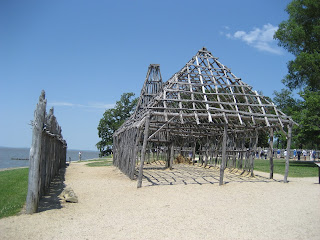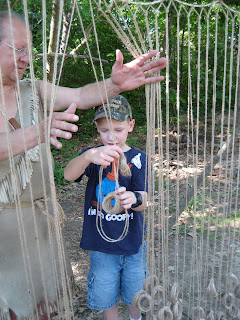After my boys posed so sweetly for the camera, they just had to climb the tree behind us of course!!!
The first stop during our visit to the Historic Triangle was the Jamestowne Settlement (the actual geographic location of the settlement). It was fascinating to actually walk around the same place that the early settlers had been! In 1607, a group of 105 men and boys and 39 crew members aboard three ships (the Susan Constant, the Godspeed, and the Discovery) landed in the southern area now known as the Chesapeake Bay. The Virginia Company of London sent the expedition to establish a settlement and they also sent orders for Captain John Smith to be a member of the governing Council.
The National Park Service provides several different programs and tours of the area. We attended one of their living history tours with this very talented tour guide! She helped us use our imaginations to go back in time and try to understand what it was like for the first settlers. It was a very difficult time in our early history as the settlers struggled to live in a new land full of challenges.
We also walked around the excavation site where archaeologists were busy finding all kinds of new evidence in the rediscovered 1607 James Fort. It was at this spot just a year ago, where they found evidence of cannibalism during the "starving time" in Jamestown from 1609-1610. Due to severe drought and harsh living conditions, hundreds of people died during this period. They did just about anything to survive. According to archaeologists, the cellar at this site where the human remains were discovered had also been filled with trash, including bones of horses and other animals consumed in desperation. So sad...
Over the years, there have been numerous unmarked graves located in the settlement as well.
After our visit to the Jamestowne Settlement, we spent another day at the Jamestown Living History Museum. This museum has all kinds of indoor exhibits describing the cultures of the Powhatan Indians, Europeans and Africans who lived in Jamestown, Virginia in the 1600s. There is also an outdoor area to explore with replicas of the three ships, and life-size re-creations of the Powhatan Indian Village and the colonists' fort during the 1600s.
Here is my tribe in their canoe :)
The boys loved exploring the Powhatan Indian Village which included reed-covered houses, tools, supplies, and even live roosters!
The rooster and Caleb...strutting their stuff!
I found this lovely mink in one of the houses....but...I don't think it is my style!!!
Skunk skin anyone???!?!?! PEEU!!!!
There were also historical interpreters there who taught us about how the Powhatans processed animal hides, weaved fibers for nets, and made tools and pottery.
Look at this cute little settler I found at the James Fort:)
This man was making a three-legged stool using 17th century style tools...
Although we enjoyed so many things here, the boys favorite was the gunsmith's matchlock musket demonstration!
The musket was so loud, we all jumped! I so was surprised I actually caught the shot camera!
As we have studied more about U.S. history the past few months, Alan and I have become really fascinated by Jamestown. The settlers at Jamestown arrived in the New World 13 years before the settlers on the Mayflower landed in Plymouth. We noticed that Virginians have lot of pride in the fact that Jamestown was the first permanent English settlement in the New World. We were curious...why does it seem that we remember learning more about the pilgrims than the Jamestown settlers? There are some differences in the reasons for the colonies which may explain why. The Virginia Company had economic motives for colonization, while the Pilgrims were motivated by freedom from religious persecution. The settlers at Jamestown were members of the Church of England, while the Pilgrims were dissenters from the Church of England and established a Puritan/Congregational church in the New World. Overall, they both played an important part in our nation's history. The National Park Service website states,
"The growth and development of these two English colonies, though geographically separated, contributed much to our present American heritage of law, religion, government, custom and language."
Jill and the boys:)


























No comments:
Post a Comment